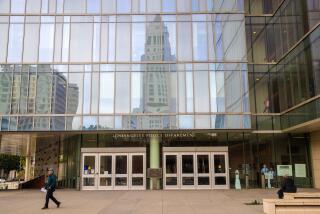TELEVISION REVIEW : KDOC Turns Cameras on Asian Gangs in Little Saigon
For its second news special, Anaheim’s KDOC Channel 56 plunges into deeper, more turbulent waters than on its maiden effort, a worthy but relatively uncomplicated look at back-yard pool safety.
This time, KDOC’s cameras hit the mean streets for a look at Orange County’s growing problems with Asian gangs.
Producer-writer-reporter Beth Bingham focuses on the Little Saigon region of Westminster and Garden Grove in “Asian Gangs--Terror in the Streets” (tonight at 8). It’s a strong 30-minute primer that would have been even more persuasive had it not relied almost exclusively on the viewpoint of the police officers who must contend with the gangs.
Yet that shortcoming may be partially reflective of the problem that law enforcement groups, which have recently come to include not just local agencies but the U.S. Bureau of Alcohol, Tobacco and Firearms, have in dealing with these groups.
As the show points out, Asian gangs differ from other gangs in part because they prey almost exclusively on members of their own community, a community than can be highly insular. In one on-camera example a shopkeeper who had complained about threats from gangs apparently changes his mind and won’t give a report when officers show up to investigate. (It’s unclear, though, whether the turnabout is because he has been further intimidated by gangs, because he is uncomfortable talking to non-Asian police officers or because of the presence of TV cameras.)
There is some shocking footage of an older Asian woman whose face has been bloodied in a gang attack, illustrating one officer’s contention that Asian gangs are “by far the most violent.” Another officer enumerates how gangs commonly terrorize women and children during home invasions or in attempts to extort money from business owners.
One Asian-American businessman suggests that victims of gangs don’t cooperate more with police because many feel the U.S. legal system protects the criminal. Victims must go public to testify against gang members, which might make them targets for reprisals. And many of the gangs’ victims are recent immigrants from Southeast Asian countries where accused criminals are guilty until proven innocent and have no rights such as bail that can keep them out of jail until they are convicted of a crime.
(KDOC itself needs to remember the innocent-until-proven-guilty concept and exercise a bit more restraint in using footage from police ride-alongs. In one segment, youths whose faces are clearly visible are shown being stopped and frisked--the implication being that they are suspected gang members who may be hiding weapons--though they are never charged with any crimes.)
This show would have benefited from even more input from the Asian community, although police officials interviewed do a good job of looking beneath the crimes to the cultural differences that exacerbate the problem.
“I’m not sure what the answer is,” says one member of a gang suppression unit. “Some of these kids come from backgrounds more violent than we can possibly imagine; some were living in refugee camps that resemble concentration camps.”
Still, many other questions go unanswered. What fforts have police made to recruit Asian-American officers to help overcome the language barrier that often hampers their investigations? What are the leaders of these Asian-American communities doing to foster greater public cooperation with law enforcement? Or would these communities rather deal with the gangs internally?
With anti-Japanese rhetoric increasing in the United States, do law-abiding Asian-Americans fear increased racism against their community because of the actions of a small percentage of Asian youths? In cities where even the use of foreign languages on business signs has stirred public debate, to what degree is the non-Asian citizenry even concerned about Asian gangs?
It’s a large subject, to be sure--probably too large to be covered in any single 30-minute show. Perhaps those questions can be addressed in a follow-up.
More to Read
Sign up for Essential California
The most important California stories and recommendations in your inbox every morning.
You may occasionally receive promotional content from the Los Angeles Times.










